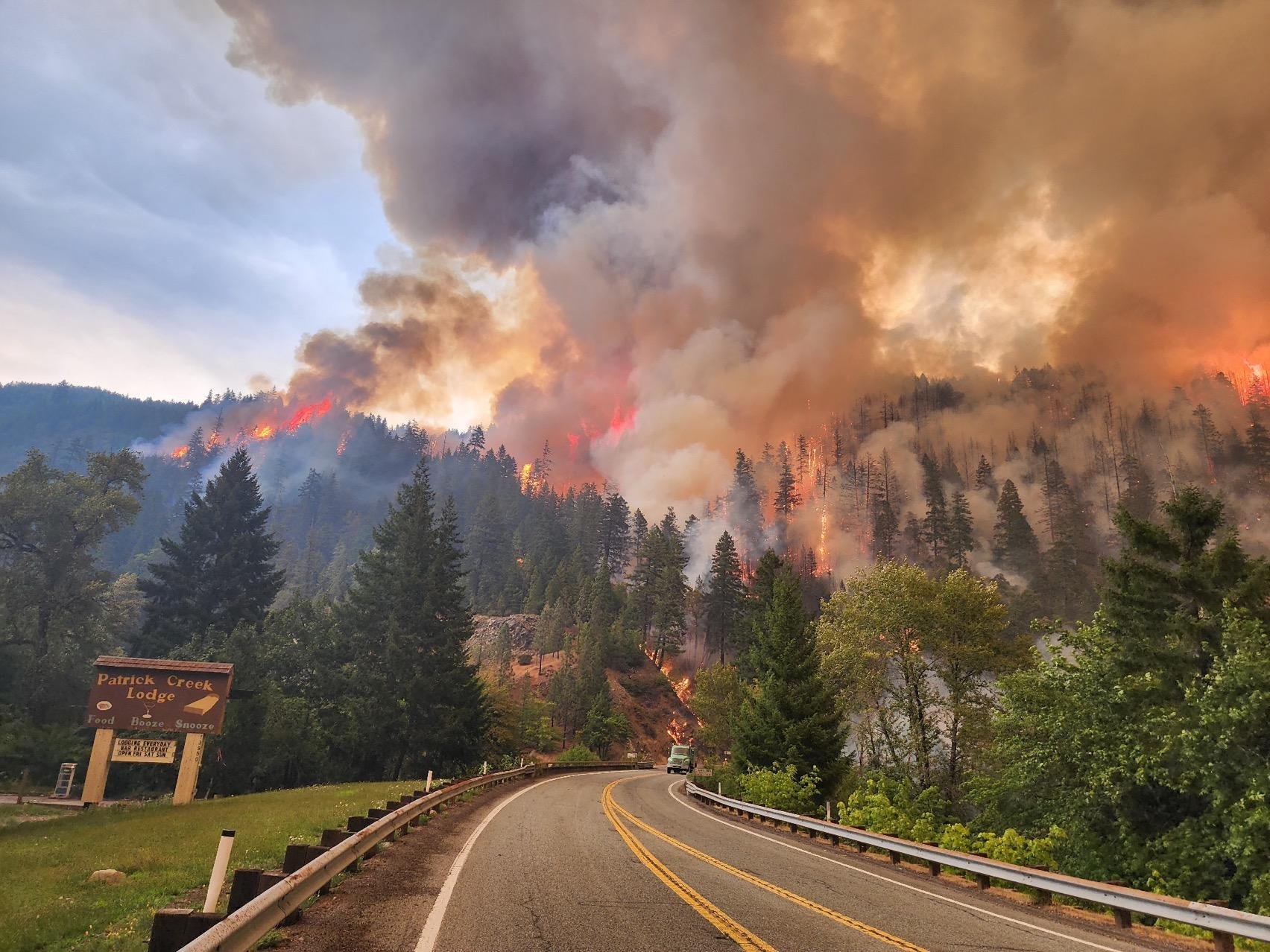2023 Wildfire Season Wrap-Up
Photo: Aerial view of the Flat Fire in southwestern Oregon, 2023. Credit: Inciweb
Written by Alexi Lovechio, October 2023
With the fire season in the rearview mirror, we offer this recap of the 2023 wildfires in the Klamath-Siskiyou region. Every fire season in the time of climate change is a chance to learn and reimagine how we interact with the landscape around us. The landscapes of our region are adapted to fire and Indigenous people have been using fire to caretake this land for millennia.
Flat Fire
On July 15th, the Flat Fire started south of Agness, Oregon, near Oak Flat Campground along the Illinois River. Dry vegetation and winds contributed to its quick spread in the initial days of the fire, which grew to 15,000 acres in 4 days. The human-caused fire burned through several old fire scars on the Rogue River-Siskiyou National Forest, including the Biscuit fire in 2002 and the Klondike fire of 2018. The fire burned over 34,000 acres making it the largest wildfire in Oregon this year. Popular recreational areas along the Rogue and Illinois rivers were closed due to wildfire activity.
Photo: Anvil Fire, 2023. Credit: Inciweb
Anvil Fire
The Anvil Fire was discovered on August 25th and is located 7.5 miles east of Port Orford, OR, on Anvil Mountain. The fire burned a little over 22,000 acres mostly In the Grassy Knob Wilderness of the Rogue River-Siskiyou National Forest. Terrain in the Wilderness area is rugged and steep with mostly large conifer trees and thick underbrush. Steep terrain and winds contributed to fire spreading quickly throughout the area. In late September, 2-4 inches of rain fell throughout the fire footprint which helped to contain and suppress the fire.
Smith River Complex
Photo: Smith River Complex Fire burning along US-199. Credit: Inciweb
On the evening of August 15th, the Six Rivers National Forest experienced approximately 150 lightning strikes, which triggered an outbreak of wildfires. Of the 27 confirmed fires from the lightning strikes, 12 were located in the Gasquet Ranger District in the Smith River National Recreation Area, creating the Smith River Complex. The wildfires were exacerbated by a year of below-average rainfall in the area, which left the vegetation unusually dry. In total, the fire burned over 90,000 acres mostly on the California side of the state line but still had a major impact on southern Oregon, with the fire burning close to the town of O’Brien. The popular and scenic US 199, that follows the Smith River, experienced intermittent closures throughout the summer due to wildfire activity close to the road and fire suppression efforts. The Smith River Complex was the Pacific Northwest’s largest wildfire in 2023.
In late September, the Six Rivers National Forest conducted a post-fire Burned Area Emergency Response (BAER) assessment to better understand post-fire effects on soil. Soil Burn Severity (SBS) maps are not an estimate of fire direct effects on vegetation, but rather an estimate of the fire effects to the soil. Soil burn severity is a good indicator of post-fire processes, because it is sensitive to the conditions that promote erosion, floods, debris flows and vegetation recovery.
BAER report estimated that approximately 51% of the Smith River Complex was either unburned/very low or low SBS, 34% was moderate and 15% was high SBS.
Happy Camp Complex
Photo: Ufish Fire along the Klamath River, 2023. Credit: Inciweb
A series of thunderstorms moved across the Klamath National Forest on August 14th, bringing abundant lightning and igniting roughly 20 fires over the western side of the forest. The most active of the resulting fires was the Head Fire, burning at the confluence of the Klamath and Scott rivers. The fire was fanned by strong winds from thunderstorms that developed in the area and burned actively, growing to 3,500 acres overnight. Several other fires in the area were being managed together as the Happy Camp Complex which grew to a total of 21,700 acres. Significant moisture over the fire area during the last week in September helped stop the fires' growth.
What can you do to help?
Support
By supporting each other through hard times our communities will grow stronger and more resilient. KS Wild asks that first and foremost, you consider contributing to the resources listed on our website for relief efforts to the impacted communities of northern California.
Prepare
Fall is an opportune time to check items off your to-do list to reduce fire risk around your home and property. The actions you take now will help reduce the chance of damage in the event a wildfire threatens your home. Check out KS Wild’s Forest & Fire Toolkit for step by step instructions on how to prepare your home.




